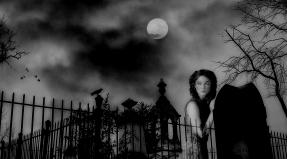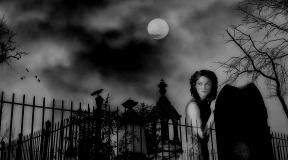Flowers for landscaping urban flower beds. Landscape forms and compositions in the urban landscape
If your dachas are fortified with fences, then you don’t have to worry about the flowers in the flower beds. It's another matter in the city.
Availability ornamental plants in front gardens and city flower beds makes them vulnerable - they can easily be dug up or torn off.
Apparently, a person has a craving for nature and beauty in his blood, and it sometimes manifests itself in such a barbaric way.
Therefore, to select colors for the city, you need to take into account some factors.
1. In city flower beds or when arranging front gardens near the house, cut plants should be abandoned. Especially those that have long peduncles. Lilies, peonies, cornflowers, and doronicums can become victims of those who like to give bouquets. They easily break off and the flower beds take on a sloppy appearance.
2. When planting old varieties or species plants - yellow daylilies, for example, they can be preserved in the flowerbed. Our old friends, red Daurian lilies, have been decorating city flower beds for a long time and do not attract much attention. But new varieties of hosta or heuchera quickly disappear from flower arrangements. We will assume that the pedigree of the flower is in this case plays against him.
3. It is not advisable to use plants in urban flower beds that require annual digging for the winter (dahlias, chrysanthemums). Their decorative effect occurs at the end of summer, and cultivation is troublesome.
4. Give preference to perennials that can grow for several years without transplanting or dividing. Among them are maquea, narcissus, sapling, Physostegia virginiana, woolly chickweed, rudbeckia, monarda.
5. Plant fast-growing ground cover plants in the flowerbed in the yard: chickweed, thyme, cypress spurge, mantle.
6. Low-growing bulbous and annual plants will also be included in the range of flowers for the front garden: Drummond phlox, pelargonium, ageratum, muscari, marigolds. With their cheerful, bright colors they will enliven any composition.
![]()
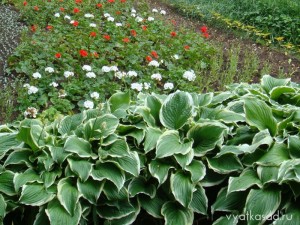
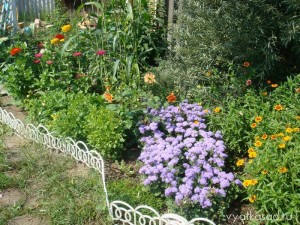
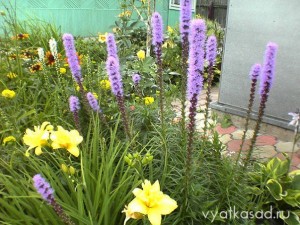
Modern Big city It doesn’t always please our eyes with beautiful views: there are usually too many cars, people, noise, bustle and everything else that makes us like to relax in resort towns or in nature, in a country house or in a country house.
Multi-storey buildings, asphalt streets, an abundance of transport, all this creates an urban landscape completely antagonistic to the natural one - hard, gray, angular, looking at which it’s no wonder you get a dose of stress every day.
City parks also very vaguely resemble natural ones, natural landscape, but much preferable to gray streets. A large number of trees and other park vegetation give a person much-needed peace and have a positive effect on his psyche. For many, leisurely walks in the park on weekends have become a good tradition, and on weekdays we still spend most of our time on the streets or underground of our cities.
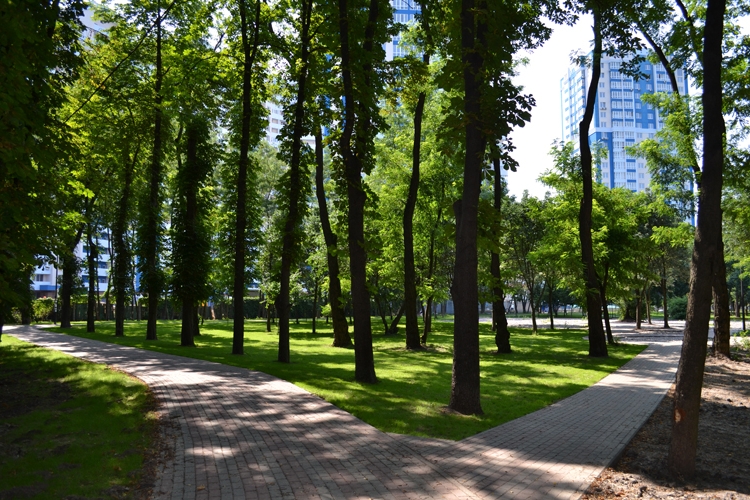
Improvement and greening of the city
It is interesting that even on gray, completely asphalted sidewalks, next to the noisy flow of cars and bustling people, you can sometimes find real works of landscape art: small flower beds, spectacular flowerpots with flower arrangements, fountains, various art objects, decorative gardens and front gardens, in private households, shops and cafes. It's especially nice to see these colorful landscape compositions against the backdrop of the grayness and, often, dirt of the surrounding urban landscape.
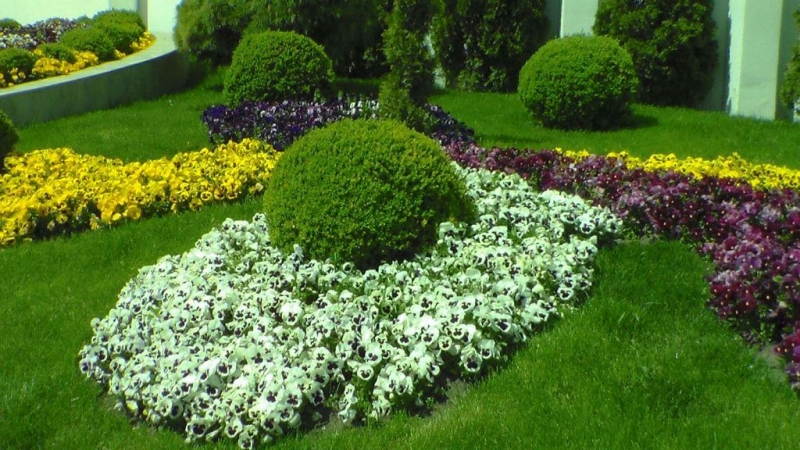
Many, even typical, flower arrangements found on city streets are so interesting and original that it will be useful to adopt architectural and landscape solutions for arranging flower beds and flowerpots, as experienced gardeners, and just for lovers landscape design.
Outdoor flowerpots and flower beds
One of the interesting compositional techniques for placing flower plants is the use of various outdoor flowerpots, flower beds and containers to form flower beds, made in various architectural styles from concrete, wood, etc.
Various options outdoor flowerpots made of concrete What unites them is their functionality: they must be roomy enough so that the soil volume is enough for comfortable growing of various plants. The practicality, stability and durability of concrete flowerbeds, flowerpots and flowerpots for placing flowers is also obvious, in addition, their appearance can be quite original thanks to the classic ornaments in the Soviet retro style.
Data concrete structures flowers can sometimes last several decades, which adds historical value to their decorative value. The severity of the geometric shapes of concrete flowerpots contrasts with colorful and elegant flowers, creating an original visual effect and decorating city streets and alleys. The landscape cost estimate for constructing concrete landscape forms consists of the costs of reinforcement, mortar, painting, rigging and loading and unloading work.
In modern urban landscape design, such retro-style art objects can be said to have come back into fashion. Despite the simplicity and monotony of the ornaments of concrete tubs, the design of each of them is individual due to the variety of flowering and coniferous plants.
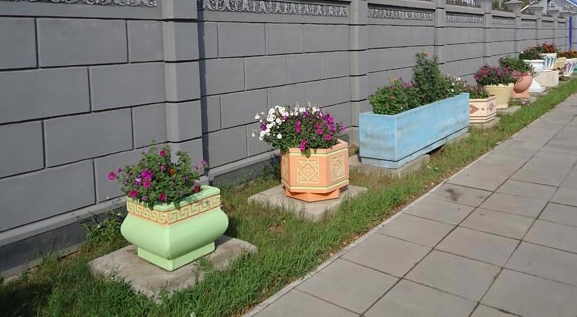
You don’t often see concrete containers for flowers in the garden interiors of private households, but in the city, especially in the central and long-built part of it, they have been decorating the streets since Soviet times.
Concrete flower beds are also a common option for landscaping and landscaping adjacent areas multi-storey buildings.
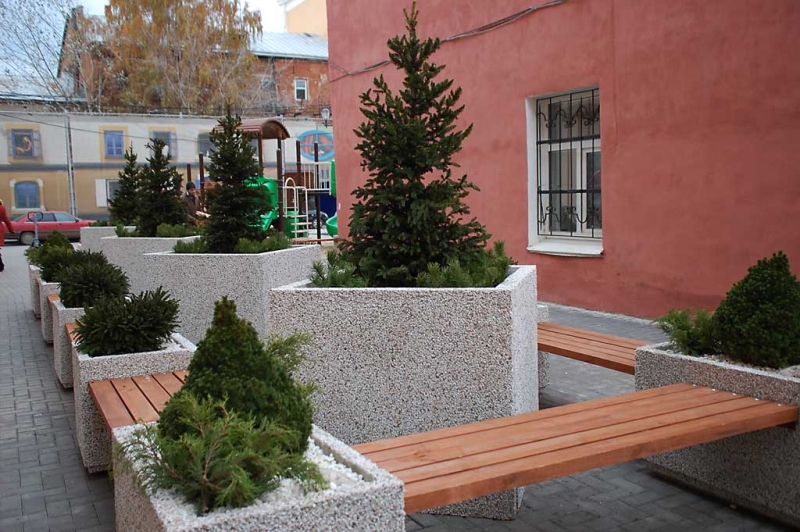
Arranging such structures for flowers with your own hands is quite difficult, so a more common solution in landscape design is the use of wooden or wood-lined containers for plants.
Wooden planters and flower boxes They are also one of the most common types of creating flower beds in the city: they can look quite impressive thanks to their bright colors, and at the same time they are practical and wear-resistant.
Flower plants and conifers can be found on central streets, near shops, near ancient buildings, in parks and squares. Plants placed in large tubs require regular and abundant watering, since moisture leaves the small volume of soil raised above the asphalt quite quickly.
Covering material that protects the top soil layer will help provide sufficient humidity and create original color combinations: pine bark, pebbles or decorative rock small fractions.
One of the classic options for organizing flower beds raised above the ground can be partitions with a height of 15 cm to half a meter or higher, the space between which is filled with fertile soil.
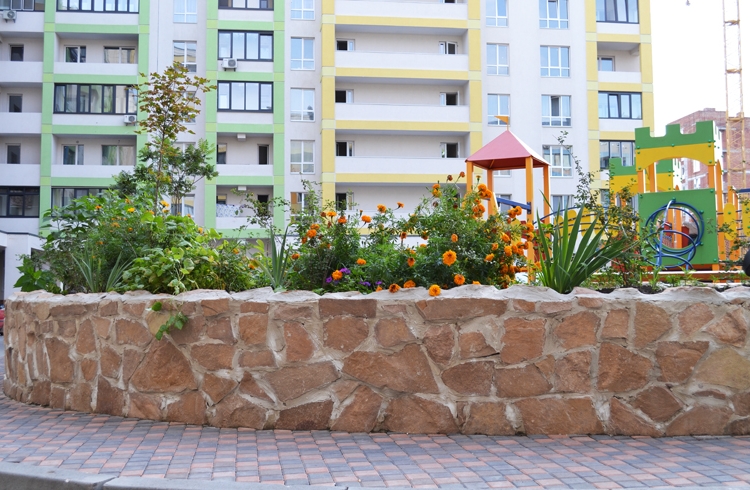
Placing plants above ground level will not only prevent waterlogging if the site is located close to groundwater, but will also help make landscape architecture more original.
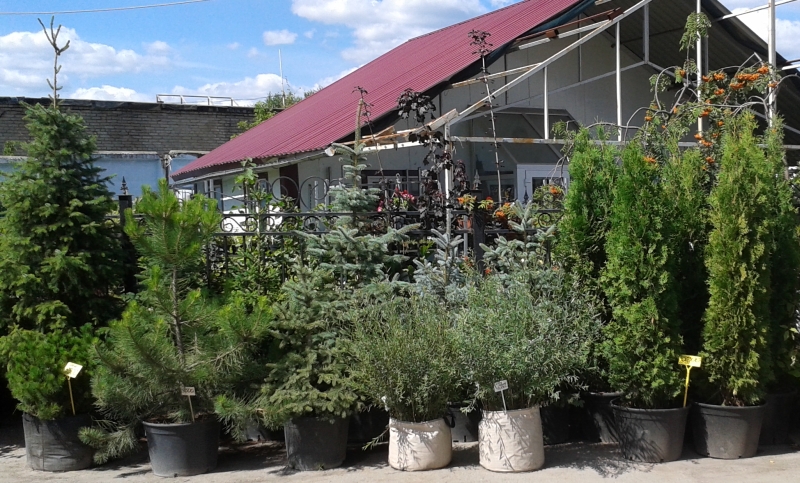
It happens that the soil on the site is excessively clayey or too light and sandy, which may not be suitable for growing all types of flower crops. The construction of a raised flower bed above ground level in a container made of concrete, wood or plastic, into which a suitable type of soil can be added, will ensure plant species diversity even at small area with a specific soil composition.
Obviously, the appearance of outdoor flowerpots is only half determined by the design of flower containers - the compositional solution of flowers and ornamental plants plays an equally important role. Beautiful flower bed will decorate any tub or flowerpot; empty soil or weeds, on the contrary, will reduce the attractiveness of even the most spectacular composition.
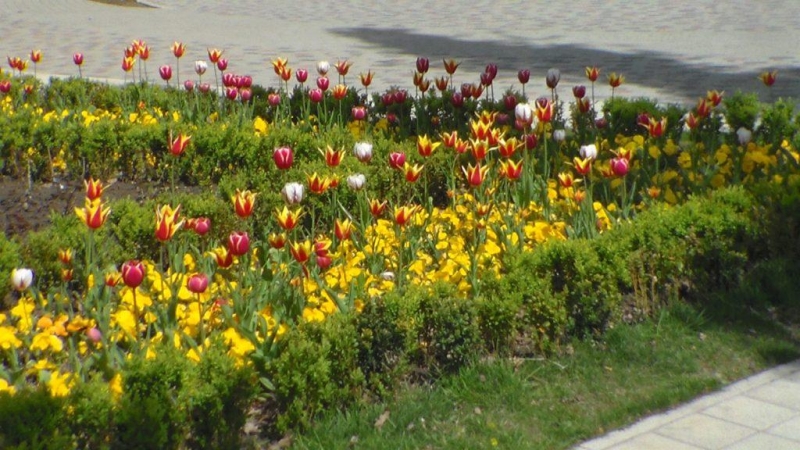
There are no strict rules for combining architectural forms with one or another plant content. At the same time, classic flower beds remain the most popular in outdoor landscape design, delighting the eye with their variegated diversity, consisting of many plants, each of which is beautiful in its own way, and at the same time, all the flowers together form something like a living carpet or bedspread with an exquisite ornament .
The most common flower plants in the flower beds of modern cities, at least in the spring, are tulips and pansies, against which perennial conifers or flowering trees are often placed. The compositional solutions used when arranging flower beds can hardly be called original, but thanks to the large number of similar flowering plants, planted in classic geometric figures, a rather interesting visual effect is created.
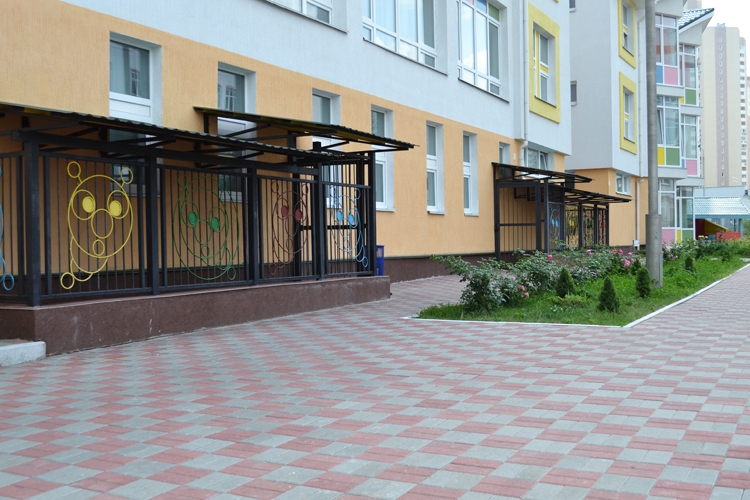
Fountains
Fountains can be considered one of the symbols of the urban landscape: regular, multi-jet, colored, cascading or musical - all this variety decorates the central streets and alleys with cheerful splashes and rainbows.
Today, European-style fountains have become fashionable, which shoot directly from special nozzles placed in openings on the same level with asphalt or paving stones. The drainage and recirculation of water is ensured by a through drainage system located below the level of the asphalt concrete pavement.
The combination of multidirectional jets and color-musical effects allows you to create original and mesmerizing compositions. At the same time, the installation of fountains of this level implies the use of rather complex and labor-intensive technologies that make it difficult to install similar landscape objects in private households.
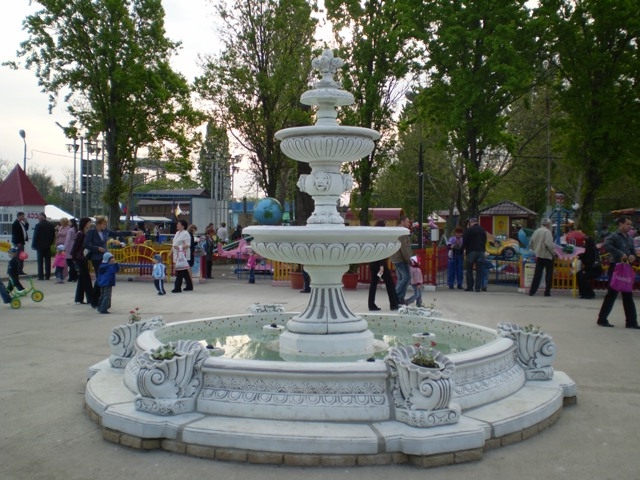
A more common and familiar option for arranging landscape water systems is a regular fountain with one or more nozzles and a bowl with sides for filling with water. The most common form is a round fountain, the bowl of which is most often decorated with colored mosaics or small squares. ceramic tiles. The color and transparency of the water are directly determined by the capabilities of the fountain’s cleaning and drainage system.
Old city fountains often have an almost magical, mesmerizing sophistication that many of their modern counterparts lack. Ancient sculptures, natural mosaics, original shape - all this adds historical and decorative value to such fountains.
Painting and landscaping of building facades
Another popular one in Lately a way to decorate the gray landscape of city streets was painting the facades of multi-storey buildings and technical buildings cities. Decorating and painting the facades of buildings - airbrushing, street art in the graffiti style is increasingly gaining popularity.
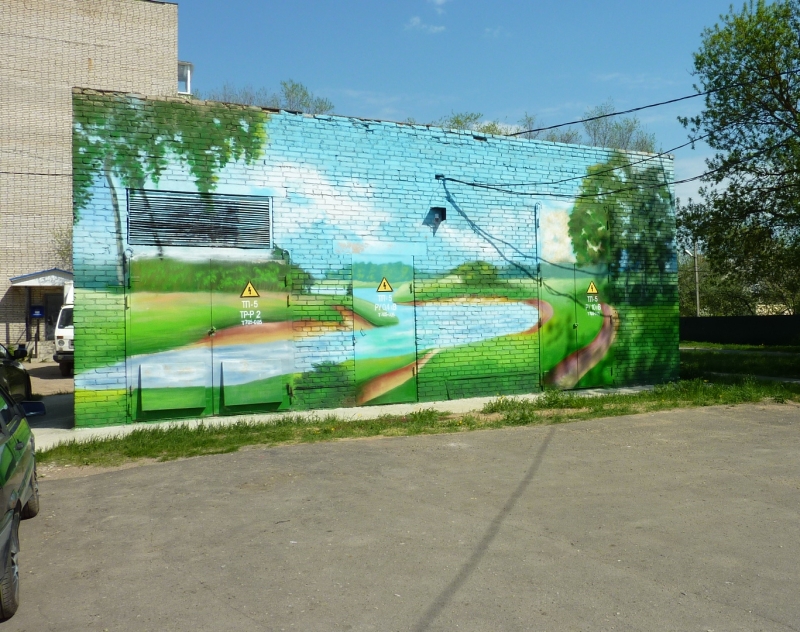
Greening of facades and roofs of buildings is also gradually becoming an element of the urban landscape, but this way to embellish the facades of buildings and add a piece of nature to the kingdom of asphalt and concrete is quite rare.
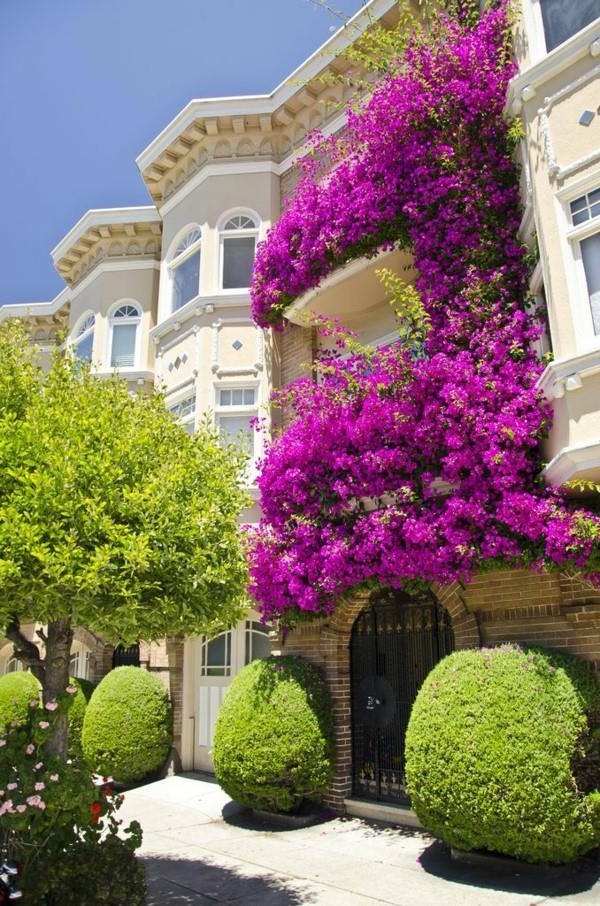
Landscaping of facades is not yet so popular, because... burdened with significant implementation costs vertical gardening, and regular plant care. In addition, the climate is less favorable than in Europe for such masterpieces; more and more often you can find similar solutions within the interiors of buildings - phytowalls.
Decorative sculptures, figurines and art objects
You can often find various modern sculptures and figurines in public gardens, parks and courtyards of the city.
Made of wood or reinforced concrete and brightly painted, they fit very harmoniously into the landscape and add their own share of attractiveness.
Various sculptures of cartoon characters and animals were most liked by children, who have a place to climb and play.
What shapes the appearance of modern cities is architecture, infrastructure and, of course, parks, flower beds, alleys and other components of urban landscape design. To make it original and pleasing to the eye, it is not enough to create new landscape elements - on the contrary, it is important to preserve the traditions and style inherent in old art objects: fountains, squares, ponds and flower beds, which have been decorating the streets of our cities for many decades.
Leafing through glossy magazines on landscape design, you sighed more than once and asked yourself the question: “How can I create such beauty? with my own hands? Naturally, in order to create landscape compositions, be it a flower bed, an alpine hill or a stream, certain knowledge is required.
HOW TO PLACE A FLOWER BED CORRECTLY - OPTIONS FOR SOLVING THE QUESTION:
If you do not have sufficient knowledge of how to plant a flower garden at your summer cottage, but you still enthusiastically take on creating it, the result may not meet your expectations. What is the way out of the situation?
There are several options: - sign up for landscape design courses, pay a tidy sum for them, spend several months and gain basic knowledge about plants, soil and flower beds. But you will still have to create flower beds yourself, making annoying mistakes and mistakes. - choose a simpler method that will give a guaranteed result - use ready-made flower bed schemes suitable for the conditions of your summer cottage.
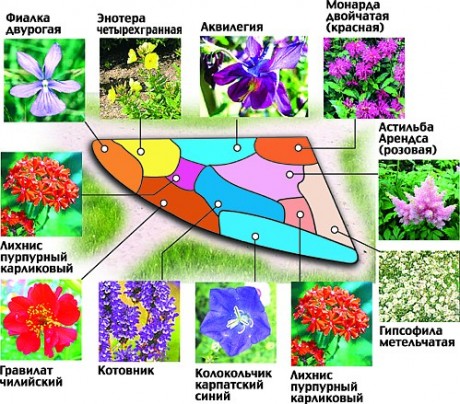
A beautiful flower bed will be made from irises of various colors, which are planted in rows on a round flower bed.
The ready-made patterns of flower beds, which are given below, will help you create compositions of perennials with your own hands, without much difficulty:
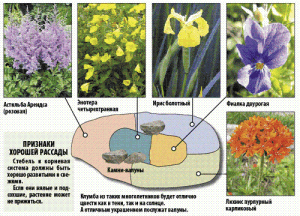
A flowerbed of perennials such as doronicum and tulip looks bright and contrasting, and its main advantage is the random arrangement of flowers, which makes it easier for a novice gardener to design a flower garden with his own hands.
Below is a plan for a flower garden that can be arranged in any part of the garden by placing several boulders and planting several varieties of perennials. Which perennials can be used are indicated in the diagram:
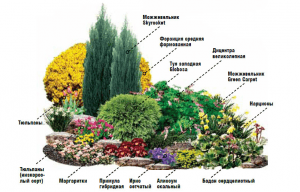
Do you have a desire to create? Then I advise you to choose another, more affordable option. This option is not as complicated as it seems at first glance if you have ready-made schemes and designs for flower beds. After studying them, you can start “painting with flowers” - create the flowerbed of your dreams with your own hands.
CHOOSE A PLACE FOR A FLOWER FLOWER:
First of all, on the plan of the dacha plot it is necessary to determine the place for the flower bed. A flowerbed can be different: a ridge or mixborder along a path, an arabesque flowerbed against the backdrop of a lawn, a rustic or romantic flowerbed in a shady corner of the garden. The shapes of flower beds are also different: geometric and free. Which flower garden to choose - it all depends on the landscape design of the site and your preferences. Flower garden-mixborder On the plan of the flower garden, it is necessary to mark the illuminated and shady places. This is very important for the right choice assortment of plants and creating optimal conditions for their development and flowering. These rules must be adhered to when forming a flower garden of continuous flowering or, as it is also called, a “flower garden of four seasons.” These flower beds look beautiful all year round.
A FLOWER GARDEN OF FOUR SEASONS IS THE DREAM OF ANY SUMMER RESIDENT:
The right combination of perennials makes it possible to contemplate the blooming splendor of plants throughout the entire season - from spring to late autumn. If you supplement the flower garden with conifers and some types of tall grasses, as well as a border of periwinkle or tenacious, the flowerbed will remain elegant even in winter. When choosing plants for a continuous flowering bed, you must remember that the number of plant species depends on the size of the flowerbed. If the flower garden is small and there are too many perennials, instead of a feeling of harmony, we get the completely opposite effect - a feeling of disorder and discomfort. Low-growing perennials reveal their beauty in large groups. Their correct placement in the flowerbed will become evident during flowering. Low-growing perennials blooming in spring (snowdrops, primroses, muscari, hyacinths) are placed in the foreground.
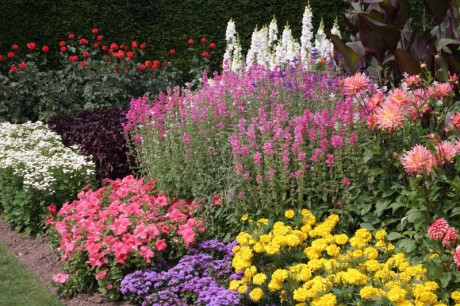
Plants of medium height (tulips, pyrethrums, foxgloves) will occupy the middle part of the flowerbed. The background will remain behind tall summer and autumn perennials - sedums, chrysanthemums, September flowers. Between them, grasses are planted - mantle and blue fescue. Naturally, you shouldn’t count on being able to create the perfect flower garden project in one season. Therefore, if there is no experience, it is better to start with schemes more simple flower beds. Mistakes made can be corrected by planting annual flowers between perennials.
FLOWER BEDS WITH YOUR HANDS ACCORDING TO READY-MAKED DIAGRAMS -
IT CAN'T CAN'T IMAGINE SIMPLE:
Here are examples of decorating a garden with your own hands, using ready-made flower bed designs.
“A PIECE OF CAKE” IN A CORNER OF THE GARDEN:
The shape of the flower bed resembles a piece of cake with a diameter of 2 meters. There is a place for such a flower garden in any corner of your garden. The color scheme of the flower bed is red-crimson and silver.
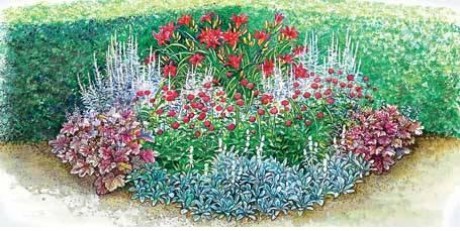
Sketch of a flower garden “Piece of Cake”
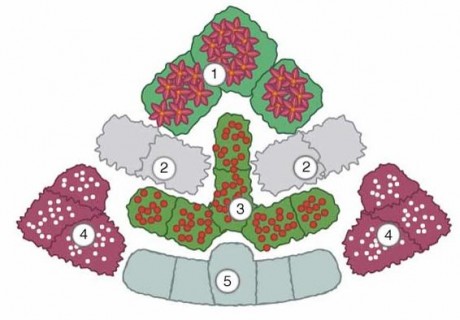
Flower garden scheme “piece of cake”
1. In the corner of the flower bed we plant dark red daylily “Ed Murray” - 3 bushes.
2. Silver leaves of wormwood “Silver Queen” will emphasize the beauty of velvety daylily flowers and create an advantageous background for heuchera - 4 copies.
3. Macedonian barkweed, variety “Mars Midget”, dark red - 6 specimens.
4. Heuchera with leaves burgundy color- 6 bushes.
5. wide part The flower beds will be decorated with silvery leaves of the chistets. We plant 5 copies.
FLOWER GARDEN LAYOUT FOR THE IMPATIENT:
If you really want to see the fruits of your labors this year, I offer a flowerbed diagram for the impatient. Its peculiarity is that all plants will require a lot of sun. The background for this flowerbed will be a fence, a blank wall or a group of coniferous plants.
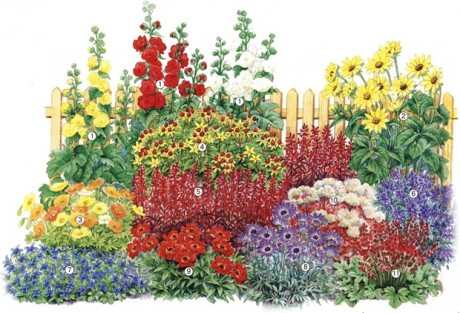
Sketch of a “flower garden for the impatient”
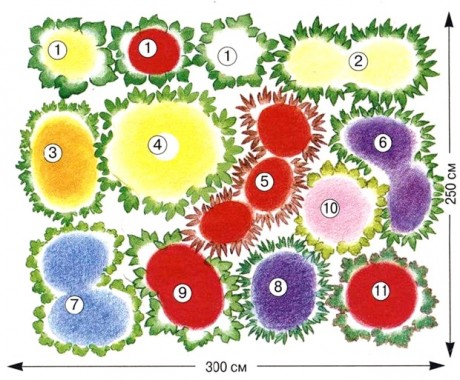
Scheme “Flower garden for the impatient”
1. In the background of the flower garden we plant white, red and yellow stock roses.
3. The Icelandic poppy will make the flower bed even brighter with its flowers.
4. Lobelia cardinalis will lie like a red ribbon in the flower garden.
Blue-blue accents in the flower garden will be placed by:
6. Catnip.
7. Poskharsky's bell.
8. Blue catananche.
Bright red spots will create:
9. Gravilate “Feuerbal”.
10. Matrona sedum will delight you with its splendor in the fall.
11. Blood-red heuchera leaves will decorate the flowerbed until frost.
MIXED FLOWER BEDS:
You can make a continuously flowering flower garden more vibrant and expressive if you plant perennial and annual plants in it. When planning to create such a flower garden, we take the same perennials as a basis and plant annuals in the free spaces between them, which will decorate the flowerbed with abundant and long-lasting flowering. Use of annual plants - perfect option when it is necessary to cover unsightly places in the flowerbed after perennials, for example, bulbous ones, have bloomed. It is better to start the process of creating a mixed flower bed armed with a sheet of paper and colored pencils. On the plan of the flower garden, the basis of which is perennials, between faded plants or in their place, taking into account the color scheme and flowering time, we “write in” annuals with pencils. This way you can choose the perfect combination of colors in a mixed flower bed.
SCHEME OF A BRIGHT FLOWDER FROM ANNUALS AND PERENNIALS:
Do you love everything bright? I offer you a flower garden project that will become a real decoration for your dacha. It is so simple that even a “teapot” can create it. The color scheme is red, orange, pink and purple tones, and, naturally, bright green leaves.
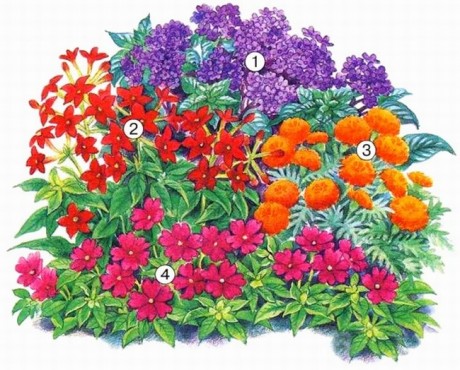
In the background of the flower bed we plant the perennial heliotrope tree (1),
the middle tier of the flowerbed is formed by Sander tobacco with scarlet flowers (2)
and double bright orange marigolds (3).
In the parterre flower beds a place was given to pink New Guinea balsam (4).
FLOWER ARRANGEMENT WITH DAHLIA:
Although dahlias are perennials that require special care: digging up in the fall and storing in the basement in winter, many gardeners really like them. Bright and expressive, dahlias will fit perfectly into a summer flower bed. The peak flowering period for these beauties is July-September.

In our flower garden scheme, a bright yellow dahlia (1) is in the center of the flowerbed, next to it are blue hybrid delphinium (2) and monarda (3). Bottom part The flower beds are allocated to Common Dubrovnik (4).
To make this flowerbed look well-groomed, it is necessary to regularly remove wilted monarda and dahlia flowers. If after the first flowering of the delphinium you remove all the flower stalks, at the end of summer it will bloom again.
FLOWER BED IN WHITE-GREEN TONES -
SCHEME OF A FLOWER BED FROM ANNUALS:
If you need to make a dark corner of the garden lighter, or bright flowers irritate you, you can use ready-made circuit a flower garden of annuals that looks very noble and elegant.
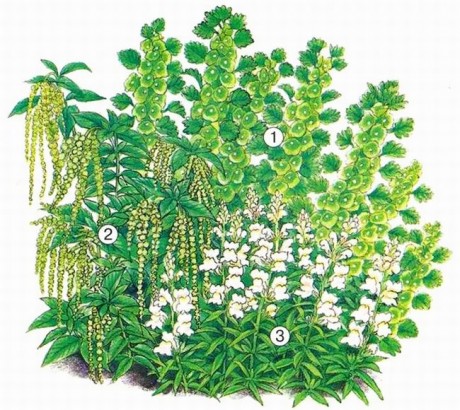
Only three plants were planted at the club:
smooth molucella (1), caudate amaranth (2), snapdragon (3), but they created a stunning effect.
WE CREATE AN ILLUSION WITH THE HELP OF A FLOWER GARDEN:
If there is a dry stream on your site, plants are planted on its banks. You might be wondering: how to properly lay out a flower garden around a dry stream to create the illusion of cool, babbling water?
Here is one of possible options. Fill the stream bed with large pebbles round shape. We paint the stones in the center blue. You can use blue glass balls for decoration. All these design “tricks” along with cold-weather plants color range will create a feeling of dynamics and coolness.
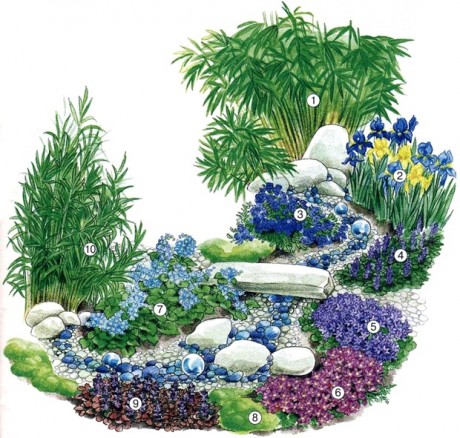
Leafy bamboo (1) will give the composition a sense of volume. If there is no bamboo, we can replace it with ostrich. Hybrids of bearded iris (2) will find their place on the bank of the stream; lobelia (3) and creeping tenacious (4) will feel good next to them. Downstream, between the boulders, will grow lush bushes of Poskharsky bellflower (5), hybrids of aubrieta (6) and large-leaved brunera (7). The awl-leaved bryozoan will add bright greenery (8). The whole composition will be completed by the creeping red tenacious (9).
A flower revolution is coming to Moscow. Previously, flower beds were usually decorated annual plants. They are bright and beautiful, but the flowers in them had to be changed at least twice a year. In autumn and spring these were tulips, crocuses, daffodils and biennial crops, in summer - petunias, tagetes, cineraria and begonias.
Now the city has a new concept - perennial bulbous plants are also being introduced into the design of flower beds. More perennial and biennial plants will be planted than annuals. The former have advantages: they do not need to be replaced frequently with new ones, you can make flower beds in the same style, and you do not have to spend money on decorative wood chips in the fall to cover the flower beds. Moreover, the flower beds are planned to be decorated in the same style. New flower beds will be designed in accordance with scientifically developed and agreed upon planting schemes. The pride of gardening and landscape construction engineers is the flower beds, which are designed to play a representative role. The largest of them is a flower garden on the dividing strip of Kutuzovsky Prospekt near the Triumphal Arch.
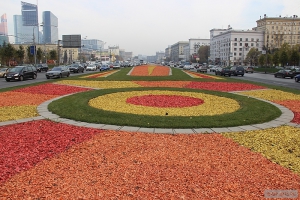
Moreover, now all flower beds will become full-fledged “citizens” - each will have a passport indicating the place of residence, size, design features and types of flowers planted, according to which the assortment is selected - now it will be difficult to pass off cheap petunias as expensive types of flowers - all will be reflected in the document.
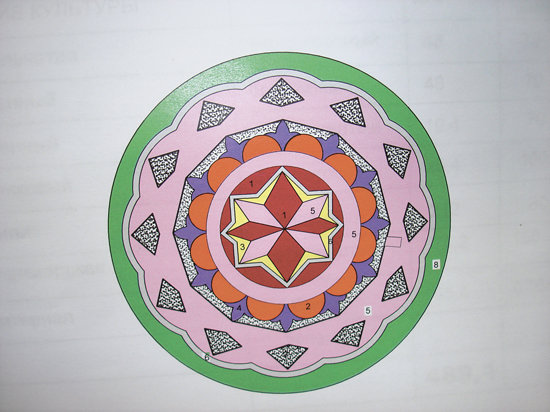
It indicates the color, number and even height of plants, as well as the area that each species will occupy in the flower garden. On the title page, as it should be in a passport, there is a photo - a sketch drawn in a graphics editor, and a detailed layout drawing is presented. The document is being approved by the Moskomarkhitektura. The color scheme is determined by the unified concept of the city's floral design.
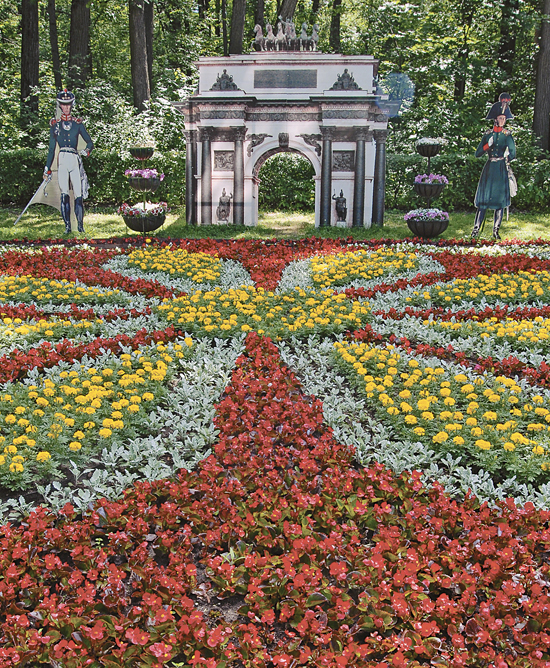
Additional landscaping is expected in the areas near 160 social facilities: it is planned to plant 850 trees and 30 thousand shrubs. The new rose gardens will be planted primarily in closed areas of hospitals, dispensaries, and sanatoriums, where roses will not be broken or dug up. About three thousand trees and 20 thousand shrubs will be planted in place of those lost under the Hole to Hole program.
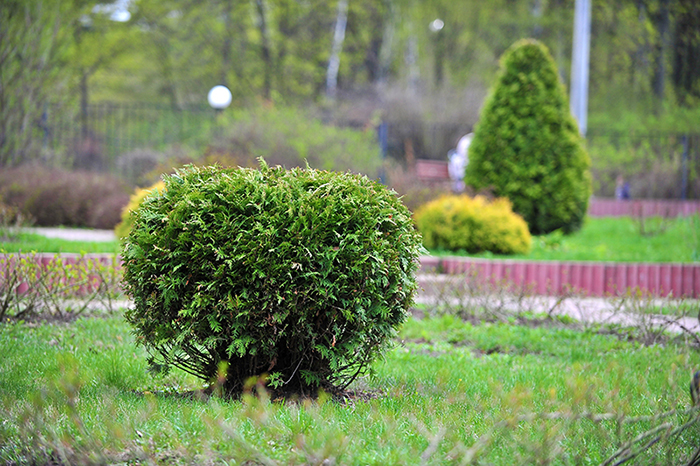
In total, Moscow will be decorated with 61 million flowers this year. Specialists from the State Budgetary Institution Moszelenkhoz warn that this year there will be increased security at the flower beds. Those who weed the capital's flowerbeds for personal interests will face administrative liability under Article 7.27 (“Petty theft of someone else's property”) and an impressive fine. If the value of the stolen plants is more than a thousand rubles, flower kleptomaniacs will face criminal liability.
Read also...
- From the order on the tasks of the Red Army Air Force due to the high accident rate From the editor: the fate of the crew
- Partisan movement in Crimea during the Great Patriotic War
- Soviet-Finnish (Winter) War: “unfamous” conflict
- Composition of the group and plans of the German command (Army Group Center) 3rd tank group of the Wehrmacht

